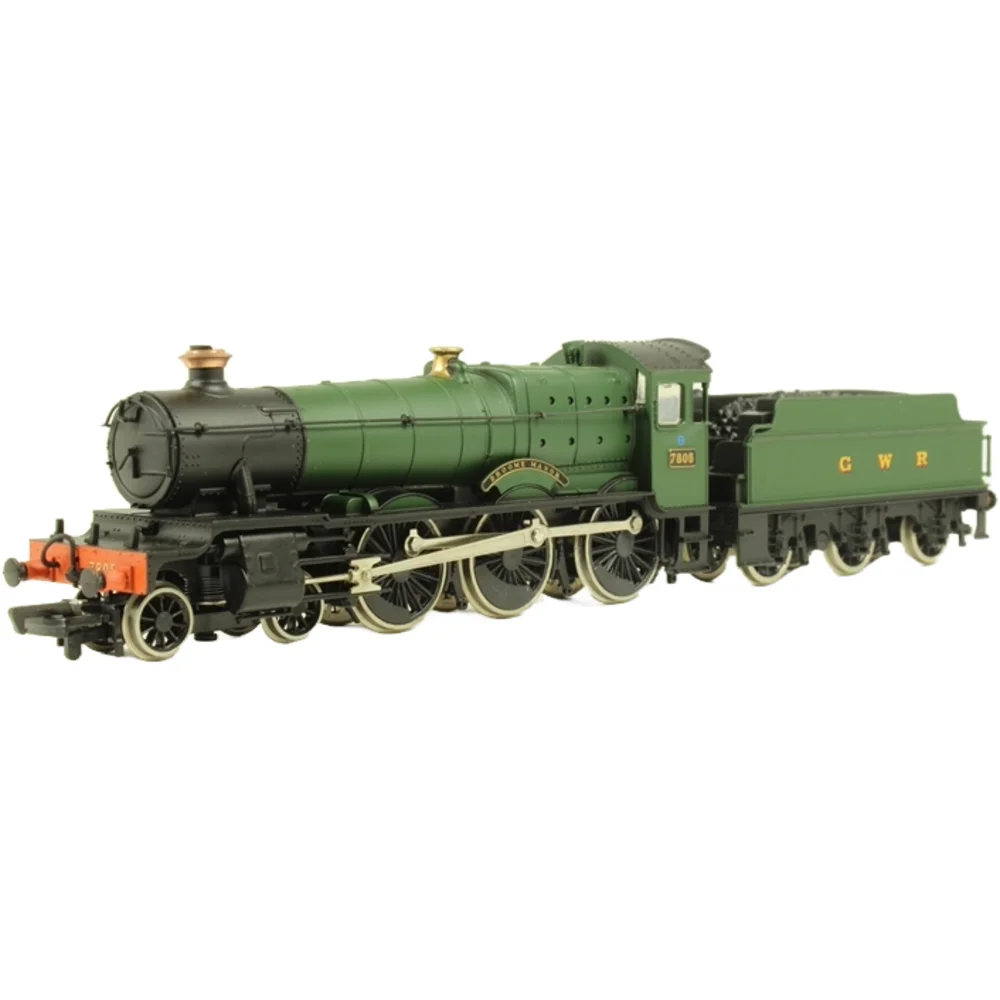Bachmann 31-305
Great Western Railway 7800 7805 Broome Manor Great Western Railway Green
Tooling
The Bachmann Branchline model of the GWR 78xx Manor Class was introduced in the early 1990s, inheriting tooling originally developed by Mainline in the 1980s. The prototype locomotives were designed by Charles Collett as a lighter 4-6-0 mixed-traffic engine for weight-restricted routes, making them ideal for Cambrian Coast and branch line duties. Bachmann’s adoption of this tooling marked a significant improvement in finish and reliability compared to earlier Mainline releases.
Tooling Features
- Scale: OO gauge (1:76)
- Construction: Injection-moulded plastic bodyshell with separately fitted details
- Detailing: Includes handrails, lamp irons, nameplates (plastic), cab glazing, and brake rigging; cab detail was basic on early releases
- Couplings: Standard tension-lock couplers, fixed mountings (no NEM pockets on early tooling)
- Finish: Accurate proportions and liveries; etched plates were not standard
Mechanical & Electrical
- Chassis: Split-frame design typical of early Bachmann/Mainline tooling
- Motor: 3-pole motor with flywheel, mounted in the locomotive
- Drive: Loco-driven wheels; electrical pickup on driving wheels only
- Minimum Radius: Second radius (approx. 438 mm)
- Weighting: Internal weights in boiler and tender for traction
- Lighting: No factory lighting provision
- Reliability: Generally smooth and quiet running, though occasional motor seating issues were reported
DCC Capability
- Status: Not DCC-ready; conversion is possible but complex due to split-chassis design
- Sound: No factory provision for speaker installation
- Community Feedback: Rated poorly for DCC ease (approx. 2/10 in reviews), requiring full isolation of motor and rewiring for decoder fitting
Liveries Produced
Bachmann issued a wide range of authentic liveries over multiple production runs:
- GWR Green with “shirtbutton” roundel
- BR Green (early and late crest)
- BR Black (plain and lined, early emblem)
- Limited editions such as Frilsham Manor in BR lined green for Brunswick Railways
Reviews & Commentary
- Detailing: Praised for accuracy and overall finish; minor criticism for sparse cab detail and fragile handrails
- Running Quality: Generally excellent, quiet, and capable of hauling moderate trains; occasional issues on pointwork
- Community Sentiment: Considered a strong upgrade over Mainline predecessors; highly regarded for prototypical accuracy
- DCC: Frequently cited as the model’s weakest point due to split-frame complexity
Media & Social Media
The Manor class remains popular in enthusiast forums and YouTube reviews, often featured in Cambrian Coast Express-themed layouts. While newer models from Dapol and Accurascale have eclipsed the Bachmann tooling in terms of detail and digital readiness, the Bachmann version retains nostalgic appeal and is still sought after by collectors.
Interesting Notes
- The tooling originated from Mainline (circa 1980) and was reworked by Bachmann in the early 1990s.
- Despite limitations in DCC compatibility, the model’s accuracy and smooth running made it a staple for GWR and BR steam-era layouts.
Class & Prototype
- Class: Great Western Railway 7800
- Traction: Steam
- Built: 1938-1950
- Total Built: 30
- Running Number: 7805
- Name: Broome Manor
- Ordered By: Great Western Railway
- Built By: Great Western Railway
- Built At: Swindon
- Built: 03/1938
- Withdrawn: 12/1964
- Length of Service: 26.8 years
- Running Numbers: GWR 7805, BR 7805
- Names: Broome Manor
Operator & Livery
- Operator: Great Western Railway
- Livery: Green
- Era: 3 - The big 4 – LMS, GWR, LNER & SR
The Great Western Railway (1835-1947) was Britain's most innovative railway company, engineered by Isambard Kingdom Brunel with his revolutionary 7ft ¼in broad gauge system. Known affectionately as "God's Wonderful Railway" and the "Holiday Line," the GWR connected London Paddington with the West Country, Wales, and Birmingham through 3,800 miles of superbly engineered routes.
Renowned for its Brunswick green locomotives, chocolate and cream carriages, and engineering excellence centred at Swindon Works, the GWR pioneered advanced steam technology under chief mechanical engineers Daniel Gooch, George Jackson Churchward, and Charles Collett. The company's legendary locomotive classes—including Castle, King, Hall, and Manor—established performance standards that influenced British locomotive design for decades.
The only "Big Four" railway to retain its original identity through the 1921 grouping, the GWR maintained its distinctive corporate culture until nationalisation in 1947. Today, the company's engineering legacy lives on through extensive preservation efforts, heritage railways, and detailed model railway recreations that celebrate the finest traditions of British steam railway operation.
